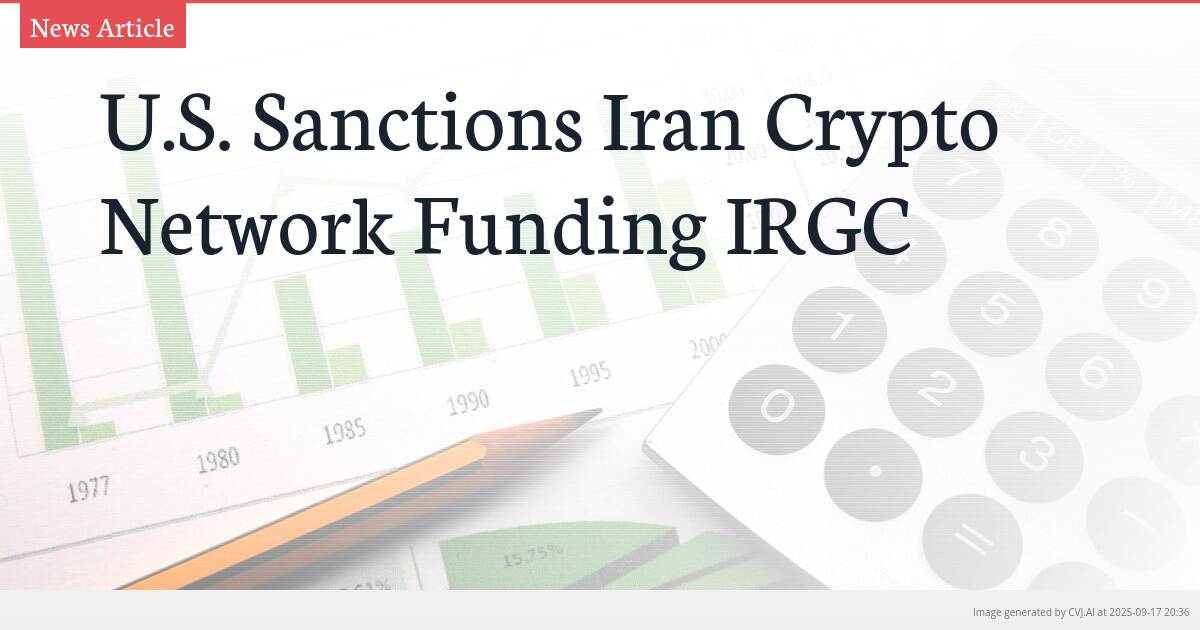This summary text is fully AI-generated and may therefore contain errors or be incomplete.
Introduction
The U.S. Treasury has launched a major offensive against Iran’s sanctions evasion infrastructure, sanctioning two Iranian nationals and a network of companies in Hong Kong and the UAE for allegedly moving over $100 million in cryptocurrency from illicit oil sales to fund Iran’s Islamic Revolutionary Guard Corps. This action represents a strategic escalation in targeting cryptocurrency as a core component of Iran’s shadow banking system, with officials explicitly naming stablecoins USDT and TRX as key tools in Tehran’s financial playbook.
Key Points
- OFAC sanctioned two Iranians and multiple companies for moving $100M+ in crypto from oil sales to IRGC-QF since 2023
- Network used front companies in Hong Kong and UAE to disguise cryptocurrency flows and involved Hezbollah-affiliated operators
- Action reflects strategic shift targeting crypto as core infrastructure for Iran's sanctions evasion, using stablecoins and layered wallets
The Shadow Banking Network Exposed
The Office of Foreign Assets Control (OFAC) has identified and sanctioned a sophisticated financial network allegedly moving massive sums through cryptocurrency transactions tied to Iranian oil sales. At the center are Iranian nationals Alireza Derakhshan and Arash Estaki Alivand, who OFAC claims have moved over $100 million in digital assets since 2023. The network utilized front companies in Hong Kong and the United Arab Emirates, including specifically named entities Alpa Trading in Dubai and Alpa Hong Kong Limited, to disguise the origin and destination of funds.
According to Undersecretary of the Treasury for Terrorism and Financial Intelligence John K. Hurley, “Iranian entities rely on shadow banking networks to evade sanctions and move millions through the international financial system.” The network’s connections extend beyond Iran’s borders, with links to Hezbollah-affiliated financial operators and Syria’s previously sanctioned Al-Qatirji Company, which has been accused of aiding the IRGC-QF. This multi-jurisdictional approach demonstrates the complexity of modern sanctions evasion tactics.
Cryptocurrency as a Core Sanctions Evasion Tool
The Treasury Department’s action marks a significant recognition that cryptocurrency has evolved from a peripheral concern to a central component of Iran’s financial infrastructure. Angela Ang, APAC head of policy and strategic partnerships at blockchain intelligence firm TRM Labs, told Decrypt that “Iran’s procurement networks no longer rely solely on front companies and bank transfers.” She noted that crypto has become “a parallel channel for moving value quickly and discreetly across borders, particularly when banks flag or reject suspicious wires.”
OFAC documentation reveals familiar patterns in Iran’s use of cryptocurrency payment rails. The process typically involves converting fiat currency into stablecoins like USDT or TRX, moving value through layers of intermediary wallets to fragment the transaction trail, and ultimately off-ramping funds through cryptocurrency exchanges with weak compliance oversight. This methodology allows Iranian entities to bypass traditional banking channels while obscuring the ultimate beneficiaries of the transactions.
The timing of these sanctions is particularly significant, coming shortly after Israel’s move to blacklist 187 cryptocurrency wallets tied to the IRGC in early September. This coordinated international approach suggests growing consensus among Western allies that digital assets represent a critical vulnerability in sanctions enforcement regimes.
Strategic Implications for Financial Enforcement
The targeting of this network represents a strategic shift in how authorities combat sanctions evasion. By designating wallet addresses alongside vessels, individuals, and front companies, OFAC is making clear that cryptocurrency infrastructure is now treated with the same seriousness as traditional financial channels. As Ang emphasized, “digital rails are a growing focus for sanctions” and cryptocurrency is “no longer a peripheral tool but a core settlement rail for procurement and finance networks.”
This action occurs within the broader context of intensified U.S. financial pressure on Iran throughout the summer of 2023. Successive sanctions rounds have targeted Iranian-linked oil tankers, shipping assets, and now the shadow banking infrastructure that facilitates these transactions. The IRGC-QF, first designated in 2007 for supporting terrorist groups, and MODAFL, sanctioned in 2019 for overseeing weapons development, represent long-standing targets of U.S. sanctions policy.
The explicit naming of specific cryptocurrencies—USDT and TRX—in official Treasury documentation signals a new level of sophistication in regulatory understanding of digital assets. This development suggests future sanctions may increasingly target specific blockchain protocols and cryptocurrency types that become favored tools for sanctions evasion, potentially creating compliance challenges for legitimate cryptocurrency businesses operating in regulated markets.
📎 Read the original article on decrypt.co

